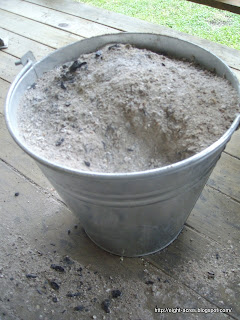Winter Woodfires: Using wood ash
As you know, through winter we heat our home and cook using a woodstove, so we produce lots of wood ash as a result.
Our previous woodstove had a very clever design where the ash tray can be pulled out and emptied easily, this makes cleaning much more pleasant than when you have to scoop out all the ash. Our current woodstove requires scooping, which can create a bit of dust in the lounge room. We have to clean out the ash tray every couple of days if we have the woodstove burning every day.
 |
| A bucket of wood ash |
We don't see the ash as a waste product though. Wood ash is all the mineral matter remaining from the wood that was burnt, so its great for adding minerals to garden soil. It usually also contains some unburnt carbon (biochar). I spread the ash through the garden and tip it into the compost as well. Wood ash is good for chickens to dust bath with, so I put it in their nesting boxes with a layer of wood shavings.
| Spreading wood ash on the garden - I just hose it into the soil |
I thought it would be simple to find out the mineral composition of ash, but it took me a while to figure out why the elemental composition didn't add to 100%. Then I realised the balance is oxygen, as all the elements are present as mineral oxides.
Anyway, the composition depends on species of wood, the part of the tree, the growing conditions AND the temperature of the fire, but roughly, its 30-60% calcium oxide, 20% potassium oxide, 10% magnesium oxide, 10% sulphur oxide, and small amounts of iron and sodium oxides, as well as trace minerals. So wood ash is a good source of calcium and potassium, and some other minor minerals. Both calcium and potassium and very important for healthy plants, so wood ash is a great way to return these minerals to the soil.
| The clever ash tray on our wood stove |
Two things to consider before you start spreading wood ash around:
1) make sure it is completely cold. I spread ash directly from the woodstove onto dry mulch once and had to very quickly stamp out a fire, even though it didn't seem hot at the time, it was still very hot inside. Its also best to use a metal bucket to store ashes, plenty of fires start from plastic buckets of ash melting through, and keep the bucket on concrete or dirt rather than wood or plastic.
2) test your soil pH as all those mineral oxides form hydroxides with water, which will increase soil pH. Soil pH tends to decrease as calcium ions are leached, so usually it is safe to add wood ash to maintain calcium ions and a neutral pH (7), but if you have naturally high pH soil, then don't add wood ash.
Speaking of hydroxides, the other use for wood ash is to soak it in water to make lye for soap making. This is the traditional method, and much more difficult that using purified sodium hydroxide (caustic soda) like we can do today. I'm tempted to give it a go one day though.
How do you use your wood ash?
Other posts about woodstoves



















Chris – if anyone can figure out how to build a brick nook it is you! I expect to see a blog post coming soon… what about an outdoor fireplace first though?
Chel – its on the list of things I want to try, but the list is so long….
Man-oh-MAN! I’ve got to get me a wood heater! If it was just a simple matter of buying one, I would. But we have to convert a wooden linen cupboard, into a brick nook, to put it. As it’s the most central place in the house, and located between two ceiling fans, we can put on reverse, to circulate the hot air. Perfect spot! Just don’t know how to build a brick nook, all the way to the ceiling!
Liz, when I saw your post title I thought you were going to say you made your own lye. LOL! No wood heater here unfortunately.
Leave a comment